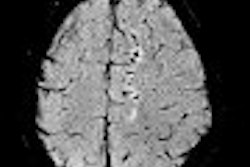Contrast-enhanced MR imaging is as sensitive as intraoperative ultrasound in depicting liver lesions before hepatic resection, according to a study published in Radiology.
Researchers from Massachusetts General Hospital in Boston hypothesized that previous reports describing the high yield of intraoperative ultrasound may have reflected more on the use of less-advanced cross-sectional imaging techniques than the inherent benefits of sonography.
Radiologist Dr. Dushyant Sahani and Dr. Kenneth Tanabe, a surgeon, retrospectively identified 79 patients who had undergone surgical resection for primary liver tumor or metastasis, and had also undergone preoperative contrast-enhanced MR imaging within six weeks of surgery. MR imaging was performed with a 1.5-tesla scanner, while dedicated intraoperative liver ultrasound was performed or supervised by a gastrointestinal radiologist, using a 7.5-MHz linear-array transducer, after hepatic mobilization by the surgeon.
The researchers relied on histopathologic evaluation of the 159 resected hepatic lesions as the reference standard. Of the 159 lesions, 138 (86.7%) were identified at both MR imaging and intraoperative ultrasound. In addition, 12 additional lesions (7.5%) in 10 patients were detected only at intraoperative ultrasound, including eight metastases, one hepatocellular carcinoma, one cholangiocarcinoma, one hemangioma, and one biliary hamartoma.
Of the 12 additional lesions found on intraoperative ultrasound, 10 were in the left lobe and seven were smaller than 10 mm.
"The failure of MR imaging to demonstrate these lesions might be secondary to ghosting artifacts, caused by the heart and aorta, that commonly appear on images of the left liver lobe," the authors wrote. "This observation suggests a limitation of MR imaging, which should be improved with use of currently available volumetric (three-dimensional) thin-section imaging performed in a single breath-hold" (Radiology, September 2004, Vol. 232:3, pp. 810-814).
Both modalities failed to depict nine lesions (5.6%), including four metastases, four hepatocellular carcinomas, and one cholangiocarcinoma. MR and intraoperative ultrasound had a sensitivity for liver lesion depiction of 86.7% and 94.3%, respectively. No significant difference was found between MR imaging and intraoperative ultrasound for lesion depiction (p = 0.8).
Surgical management was altered on the basis of intraoperative ultrasound findings in only three (4% of the total patient group) of the 10 patients with lesions discovered only from the modality. However, intraoperative ultrasound proved useful to the surgeon in delineating the vascular plane for resection, the researchers found. Sonography was also judged to be beneficial for depicting venous thrombus, showing the relationship between tumor and vessels, and differentiating between extrinsic venous compression and tumor extension into veins.
In addition, the team found that small simple cysts were confidently diagnosed with intraoperative ultrasound.
"In view of these advantages, we believe that intraoperative ultrasound is useful in the surgical planning of hepatic resection, although its use rarely results in the modification of surgical planning because of increased lesion detection," the authors wrote. "In addition, it is better to screen patients with preoperative MR imaging and exclude those who may not benefit from surgery, before contemplating the use of intraoperative ultrasound."
The researchers attributed MR's improved performance to technologic advances, including availability of high-field-strength magnets, the use of phased-array coils, inherently high soft-tissue resolution, and multiplanar capability. In addition, the modality's diagnostic accuracy and sensitivity have been bolstered by new techniques such as breath-hold acquisition, fat saturation, 3D imaging, and multiphasic imaging after contrast agent administration, the authors wrote.
Liver-specific contrast agents also increase the imaging window for evaluation of liver, and permit the acquisition of thin sections with high spatial resolution, they noted.
"Intraoperative ultrasound continues to be an excellent imaging tool for the planning of liver resection for neoplasms, because it delineates the hepatic vasculature and its relation to the neoplasms," the authors wrote. "With further advances in preoperative MR imaging techniques, intraoperative ultrasound would probably depict additional lesions less often and would rarely change the planned surgical procedure."
By Erik L. Ridley
AuntMinnie.com staff writer
September 29, 2004
Related Reading
Intraoperative MRI data can alter the course of brain operations, September 28, 2004
MRI successfully guides RF kidney tumor ablation, September 13, 2004
US-guided biopsy diagnoses early cancer in cirrhosis patients, September 13, 2004
3D ultrasound poised to revolutionize pelvic imaging, September 9, 2004
Radiofrequency ablation effectively treats large liver tumors, March 22, 2004
Doppler ultrasound indices come up short in liver disease assessment, February 26, 2004
Copyright © 2004 AuntMinnie.com


















